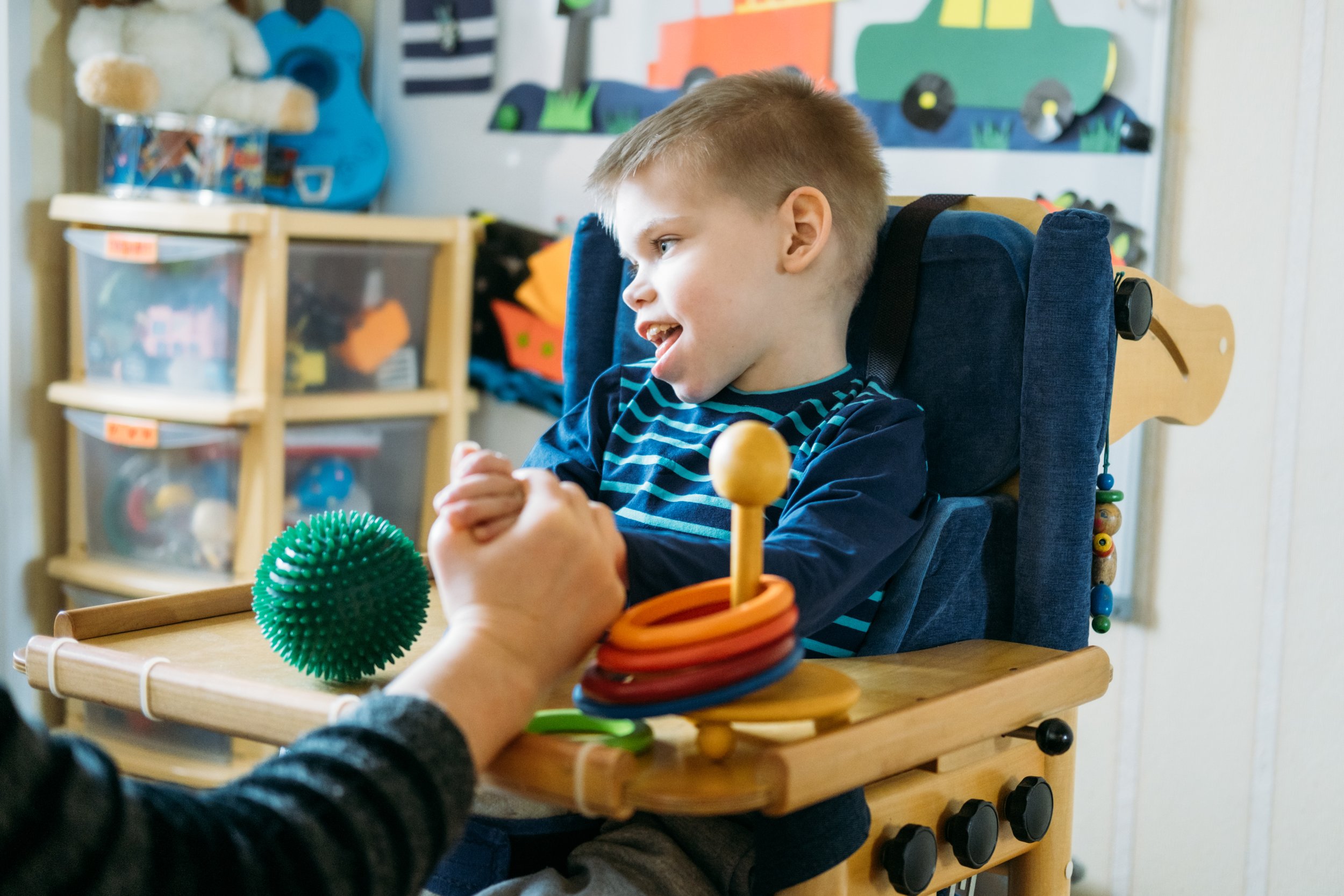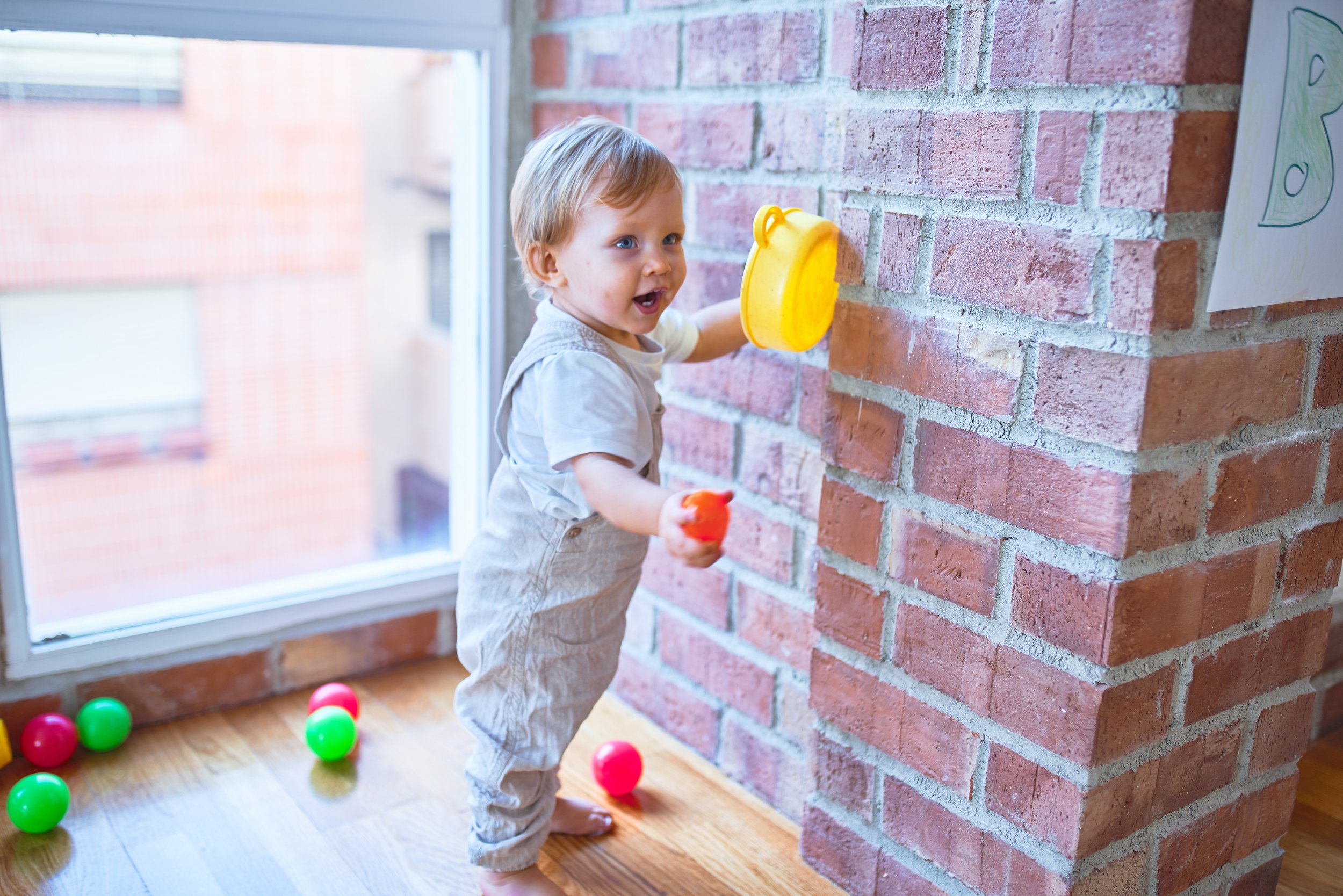Does your child look when they hear a sound?
Looking toward sounds is an important foundation for building attention and language understanding — when children respond to sound, we know that they hear it.
Your baby may have passed their newborn hearing test, but doesn’t respond to sounds now. And maybe you’re wondering how you can help them respond to sounds better or if they need another hearing evaluation.
It’s possible that your baby passed their newborn hearing test, but is having trouble hearing now. Because of the shape of toddler’s ears they are prone to ear infections and wax that can make it harder to hear. Pediatricians, ENT doctors, and pediatric audiologists are ear experts! It’s important to get their help with your toddler’s ears because some “home remedies” (like Q-tips) can have a very harmful and severe impact on your child’s hearing.
It’s important to note that just because your child responds to one particular sound, it doesn’t mean they can hear every sound.
If your child rarely responds to sounds or often appears to ignore you, you should talk to your pediatrician immediately about scheduling a hearing assessment for your child. A pediatric audiologist will be able to take a closer look at your child’s hearing and may recommend hearing amplification.
Finding a pediatric audiologist near you
If you are concerned your child might be having trouble hearing, you can find a pediatric audiologist who can complete a thorough hearing test by talking to your pediatrician. Your pediatrician can recommend an audiologist who is covered by your child’s insurance plan or maybe even connect you with a state program that completes hearing tests for free.
Now, let’s take a look at how to help your child respond to different sounds (and eventually to their own name).
Please keep in mind, if your child is having a hard time hearing these activities are not likely to help so be sure to talk to your child’s pediatrician about a hearing assessment.
This lesson and these activities are ones we use in speech therapy with children who have known developmental diagnoses; you’ll know if this lesson is a good fit for you 😊
Tips for encouraging your child to look towards sounds they hear
Tip 1 - Eliminate background noise and distractions
Start by setting your child up for success by eliminating as many distractions and background noises as you can. Turn off the TV or any loud fans, and make sure the dishwasher isn’t running in the background. You might also politely ask that other people stop talking.
It is important that the environment you choose is as quiet as it can be in order to help your child hear the sounds you're practicing with. This will also ensure that you are the most exciting and engaging thing in the room.
Tip 2 - Practice with clapping, toys, or musical instruments
Now we’ll start working with sounds. I recommend practicing with sounds that are fun and motivating for your child. For this skill, you are not practicing with spoken words or sounds yet. Rather, practice with music, instruments, loud noises like clapping, or toys that make sounds.
The goal is for your child to stop playing with whatever’s in front of them and look around to find the sound until, ideally, they look toward you. For this to work, it’s important to make sounds either behind your child or off to their side. For example, you might place a toy fire truck behind your child and push the button to make the siren go off.
Make sure to mix up the types of sounds you make and how often you make them. Otherwise, your child may catch on to your game and get bored, which usually means they’ll stop responding to your sounds. When they do turn to search for a sound, make sure to give your child positive social reinforcement by smiling, laughing, clapping, or tickling them.
Practice with this game for about 3-5 minutes at a time. If your child is very active, try practicing while they’re calmly having a snack in their high chair — this way, you can position yourself behind them without them automatically turning for you.
Tip 3 - Motivate your child by pairing a speech sound with something they’ll be excited to see
Research shows that toddlers are more likely to respond to a melodic or excited voice tone than a serious or flat-toned voice. To make this game more fun and engaging for your child, sit behind or beside your child, make a fun speech sound or word, and when they turn to you, show them something fun or exciting.
For example: you could say “hi!” or “wee!” or “yay!” and blow bubbles when they turn to you, or you could say “choo-choo!” and show them a train. Anything you think will excite them as a reward for turning to look!
Make sure you’re positioned behind or beside your child, and remember to hide the exciting toy you might be using. That way, you can tell if they are truly turning toward the sound you make, not just randomly looking at you or searching for the toy.
After you teach your child to respond to speech sounds, they will be ready to learn how to respond to their name!
Download our Responding to Sound Activity Guide to see all 3 at home activities ↓
Responding to Sound Activity: Family FaceTime
What you’ll need:
Phone, iPad, computer with video calling app (facetime, zoom, whatsapp etc)
Family or friend available to video call - they may have toys/items that make sound with them
Set-up:
Prepare a family member/friend that you are going to video call them with your child—let’s call them the “video partner” for now. Explain that you are practicing having your child listen and respond to new sounds and that you’d like their help. You’d like them to talk to your child or to sing or make silly noises when your child isn’t looking—the idea is to get them to look at your video partner based on their sound.
What to do:
Sometimes as parents we can feel like we're bored of only hearing our own voices every day, while home with little ones. This is where video calling, FaceTime or other video conferencing programs come into play, to call other family and friends.
When you call your video partner, your child may look at them on the screen, or may not. Either is fine.
If your child is interested in your video partner, encourage that interest/play/communication. Wait to practice this skill until your child loses a bit of interest, or moves away, or gets distracted with a toy at home. Then cue your video partner to start to try to get your child’s attention—with their name, or singing, or making silly sounds, or even playing with a toy or instrument that has sound.
As your child responds to your video partner's sounds, by stopping their play, or looking around or looking toward the screen, give your child a big playful reaction, "You heard it! You heard Grandpa blowing raspberries! Let's go do more with Grandpa!” And then encourage additional interaction, communication or play with your video partner.
Toddler’s interest to others’ on screen can be highly variable, and this activity may not connect with your child. Some children are more intrigued by seeing other kids on screen, so you could try this with children of friends, cousins etc, if available.
And if video calling is just not engaging to your child, that’s ok!! Here’s 2 other variations:
Video recording options:
Have family/friends make some video recordings of themselves making sounds, talking or singing to your child. When at home, when your child isn’t looking, turn on those videos (on your phone, ipad, computer etc) to see if your child responds to sounds of other voices besides your own
You can also have family/friends available to visit with you and your child doing the same basic activity as above. It’s just in-person, instead of via video/screen
What to say:
Give your child lots of encouragement when they respond to hearing others make sounds. Things like “oh, you heard that!” or “oh you heard ____ singing” or “Johnny is loud when he’s dancing for you, he’s so loud!”
Download our lesson guide to get 2 more activities for helping your child respond to sounds ↓
You May Also Like These At Home Speech Therapy Tips And Activities:
Created In Collaboration By:
Stephanie Keffer, MS CCC-SLP
Stephanie Burgener-Vader, MA CCC-SLP
Melissa Sartori, MS CCC-SLP
Yvette Faire-Bostick, MS CCC-SLP
© 2020-2025. Stephanie Keffer Hatleli, MS CCC-SLP. All Rights Reserved.
The content offered on ToddlerTalk.com is for informational purposes only. Toddler Talk is not engaged in rendering professional advice, whether medical or otherwise, to individual users or their children or families. No content on this site, regardless of date, should ever be used as a substitute for direct medical advice from your doctor, speech language pathologist, or other health professional. By accessing the content on ToddlerTalk.com, you acknowledge and agree that you are accepting the responsibility for your child’s health and well-being. In return for providing you with information related to home speech and language practice, you waive any claims that you or your child may have as a result of utilizing the content on ToddlerTalk.com.



